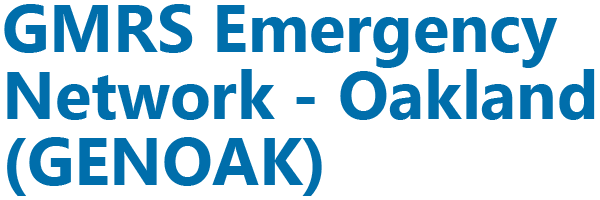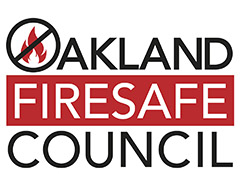GMRS 2-Way Radios
GMRS for use with GENOAK
Any local (Oakland/East Bay, CA) individual, neighborhood group, CERT Team, community hub or organization with a “repeater-capable” GMRS 2-way radio (see below) and FCC GMRS license is welcome to participate in the GENOAK network for emergency communications.
GENOAK operators are also encouraged participate in the regular monthly check-in net.
FRS/GMRS Service and Radios
FRS (Family Radio Service) and GMRS (General Mobile Radio Service) are FCC-regulated radio services in the UHF frequency band designed for short-distance, 2-way communications. Radios that work with both of these services were called “FRS/GMRS” radios, and new (2017) FCC rules reclassify these as “FRS-only” (FRS) and “GMRS-only” (GMRS) radios, based on their features and capabilities.
2-way GMRS radios are available in portable handheld and mobile/base station versions. Handheld 2-way radios can also be called walkie-talkies, handie-talkies or just HTs (handheld transmitters/handie-talkies). Mobile radios can be installed in vehicles or used as home base stations and often have more features and can transmit with more power than handhelds. Handhelds have the advantage of being portable and are usually less expensive.
Anyone in the local area with an FRS or GMRS 2-way radio can listen to (monitor) GENOAK communications on Channel 17 (462.600 MHz) with the “Privacy Code” set to 0 or “Off”.
Click Here for Details on FRS/GMRS Radio Frequencies and Channels
Two-way radios by definition transmit and receive voice/data via electromagnetic radio waves. FRS and GMRS are FCC-regulated services that utilize designated radio wave frequencies around 462 and 467 MHz in the Ultra High Frequency (UHF) FM band.
These FRS/GMRS frequencies are assigned to channels numbered 01 – 22. There are 8 additional channels/frequencies for GMRS repeater input use only. The FCC updated FRS/GMRS channel/frequency assignments and associated rules in 2017 and all FRS and GMRS radios sold today should adhere to these new rules.
Note that FRS and GMRS share channels 01 – 22. Individuals with a GMRS license are allowed to transmit at a higher power on channels 01 – 07 and 15 – 22. “GMRS-only” radios typically support both FRS and GMRS transmit power settings and they usually allow their antennas to be upgraded (see below). GMRS-only radios can also support short data messaging applications including text messaging and GPS location information.
Two-way radios can only communicate with each other (direct radio-to-radio/simplex or via a repeater) by being on the same frequency. Be aware that older FRS-only, GMRS-only or FRS/GMRS radios may not adhere to all of the 2017 FCC channel/frequency assignments. For example, older Motorola P1225 and ICOM IC-F21GM radios do not. This can cause confusion and users of these radios need to understand the channel/frequency assignments that their particular radios use.
GMRS Radio Recommendations
As of January, 2025, the following repeater-capable GMRS radios can be used with GENOAK. There are several others in addition to those listed below. New GMRS radios are introduced regularly, and as individuals may have different needs or constraints please feel free to contact us for a radio recommendation.
Note that there are other radios on the market that have the ability to communicate with the GENOAK repeater, but these may not be legal to use. The FCC has a “Part 95” certification that FRS/GMRS radios must adhere to.
We can program most of these radios for you to access the GENOAK network and other local GMRS repeaters.
The radios below are listed alphabetically. Those noted with an * have been the most popular for GENOAK use. Prices should be accurate as of January, 2025, and discounts are often available.
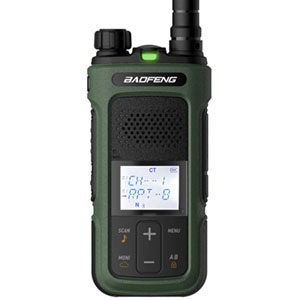
1. Baofeng G11S *
The Baofeng G11S (and similar Retevis RB27) is a low cost, solid and very easy-to-use GMRS-only handheld radio. It can monitor (receive) VHF/UHF frequencies (e.g. 2m Amateur/Ham) plus NOAA weather and commercial FM radio, which can be useful. This is a 3 watt radio that is FCC Part 95 certified and repeater capable. While 3 watts is less than most GMRS radios, it is often sufficient. The G11S can be programmed using free software (CHIRP, as a Retevis RB27) and a programming cable. Charging is via a USB cable. Current price for a pair of (2) G11S radios is $45.
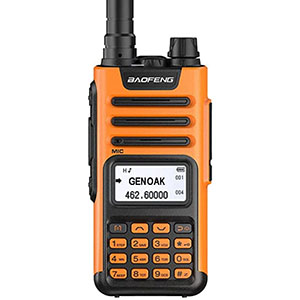
2. Baofeng GM-15 Pro/Radioddity GM-30 *
The Baofeng GM-15 Pro (and similar Radioddity GM-30 and Retevis RT76P) is a 5 watt GMRS-only handheld radio with a full keypad and a very readable screen. It can also monitor (receive) a second channel as well as VHF/UHF frequencies (e.g. 2m Amateur/Ham) plus NOAA weather and commercial FM radio, which can be useful. This is an inexpensive and quite capable FCC Part 95 certified radio that comes in several colors including more visible orange, yellow and red. It can be programmed using free software and a programming cable. Charging is via a USB cable. Current price is $30. These may come in a 2-radio bundle that is a bit less per radio.
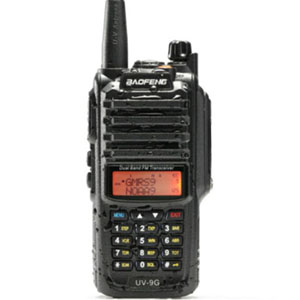
3. Baofeng UV-9G
The Baofeng UV-9G is a 5 watt GMRS-only handheld radio with a full keypad and an IP67 water resistance rating. It can also monitor (receive) a second channel as well as VHF/UHF frequencies (e.g. 2m Amateur/Ham) plus NOAA weather and commercial FM radio, which can be useful. This is an inexpensive and quite capable FCC Part 95 certified radio. It can be programmed using free software (CHIRP) and includes a programming cable. Current price is $35.
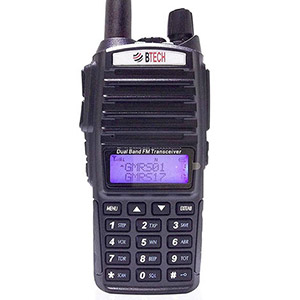
4. BTECH GMRS-V2
The BTECH GMRS-V2 is a GMRS-only handheld radio with a full keypad. It can also monitor (receive) a second channel as well as VHF/UHF frequencies (e.g. 2m Amateur/Ham) plus NOAA weather and commercial FM radio, which can be useful. This is a 5 watt Baofeng radio that is FCC Part 95 certified and repeater capable. It can be programmed using free software (CHIRP) and a programming cable. Current price is $65. For more information and to purchase, check out BaoFengTech.com.
The BTECH GMRS-PRO is customizable GMRS-only radio with Bluetooth, GPS (uses downloadable maps) and a compass for $155. The PRO can send text messages and share locations with other PRO radios (simplex only).
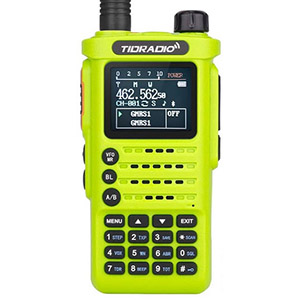
5. TIDRADIO TD-H3/TD-H8 (GMRS Version) *
The TIDRADIO TD-H3 and TD-H8 are solid and capable GMRS handheld radios with nice color screens (the TD-H8’s is slightly larger.) They can monitor (receive) VHF/UHF frequencies (e.g. 2m Amateur/Ham) plus NOAA weather and commercial FM radio, which can be useful. The TD-H3 is a 5 watt radio and the TD-H8 is an 8 watt radio, both are FCC Part 95 certified and repeater capable. They can be programmed using free software (CHIRP) and a programming cable, or wirelessly over Bluetooth. Charging is via a USB cable. Current price is $40 for a TD-H3 and $70 for a TD-H8.
Note that both the TD-H3 and TD-H8 come in 2 “versions”–GMRS and Ham/Amateur. These are actually the same radio, just configured differently. For GENOAK it is advisable to purchase the GMRS version as the default GMRS channels will already be programmed. Either version can be configured to operate on GMRS and/or Ham/Amateur frequencies, so if you later get your Ham/Amateur license you can simply reset the radio to enable transmitting on the Ham/Amateur VHF/UHF frequencies as well as GMRS (FCC certification debatable…).
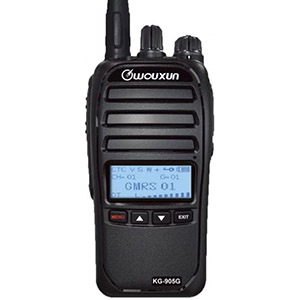
6. Wouxun KG-805G/KG-905G *
The Wouxun KG-805G/KG-905G are “business quality” GMRS-only handheld radios. They deliver 5 watts of power, are repeater capable and have good audio quality. They are durable, FCC Part 95 certified, very simple to use (no keypad) and can be programmed using free Wouxun software and a programming cable. They receive commercial FM radio stations and UHF (Ham) frequencies, but they do not receive VHF (Ham) frequencies or NOAA weather channels. Current price is $80 for the KG-805G and $100 for the KG-905G. For more information and to purchase, check out BuyTwoWayRadios.com.
GENOAK provides a Quick Reference and User’s Guide for the Wouxun KG-805G radio here.
Wouxun also offers higher-end KG-935G, KG-UV9G, KG-S88G and KG-Q10G GMRS-only handheld radios. These are excellent, high-quality GMRS radios at a higher price than the 805G/905G. They have full keypads and more features that may include a color screen, VHF/NOAA reception and better weather protection.
For a feature comparison of all Wouxun GMRS radios, check out this blog post on BuyTwoWayRadios.com.
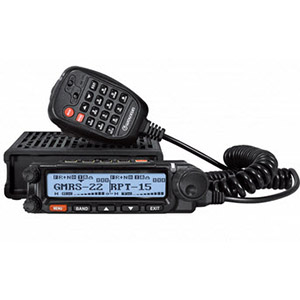
7. Wouxun KG-1000G/KG-1000G Plus Mobile *
The Wouxun KG-1000G/KG-1000G Plus is a mobile/base station GMRS-only radio. While much more expensive ($370/$390) than a handheld GMRS radio, it also has more features and power (50 watts). The KG-1000G/KG-1000G Plus needs an external 12v power supply (like this) or to be mounted in a vehicle and powered by the 12v battery, and it requires an external antenna and coax cable. This radio is FCC Part 95 certified, can receive VHF/UHF frequencies (e.g. 2m Amateur/Ham) plus NOAA weather and commercial FM radio, and can be programmed using free Wouxun software and a programming cable.
The Wouxun KG-XS20G is a compact, less powerful (20 watts) and less expensive ($200) version of the KG-1000G. It requires the same type of external 12v power supply, antenna and cable. For more information check out BuyTwoWayRadios.com.
There are other mobile/base station GMRS-radios that work well, including the Radioddity DB20-G/DB25-G, BTECH Mobile GMRS-50X1, Midland MXT400/MXT500, Retevis RA25, etc.
Older Motorola and Kenwood UHF mobile radios (like the Kenwood TK-880) are available used and can be a bargain if they are in good, operable condition.
Berkeley’s BeCERTAINN program has published a comprehensive list of GMRS radios. Most of them will also work with the GENOAK repeater. And the Richmond/Marina Bay CERT group provides an excellent review and their recommendations of various GMRS radios.
What about my older FRS/GMRS radio?
Prior to 2017 many manufacturers made combination FRS/GMRS radios. These were often sold in a “bubble pack” of 2 radios. Brands include Motorola, Uniden, Midland and Radio Shack. Unfortunately, with the exception of a couple Motorola models (MS350R and MR/MS355R only), none of these FRS/GMRS radios are repeater-capable, and therefore none will work with the GENOAK network. They are, however, very usable for FRS communications. Midland still sells the GXT1000/1050 FRS/GMRS radio, but it does not work with a repeater and therefore does not work with the GENOAK network.
What about those inexpensive 2-way VHF/UHF radios?
The Baofeng UV-5R and UV-82HP are examples of popular, inexpensive and quite capable VHF/UHF radios that transmit on FRS/GMRS channels/frequencies and work with repeaters. These, however, are not FCC Part 95 certified (as of January, 2025) and as such, they are not legal for FRS/GMRS use and thus cannot be recommended by GENOAK.
Also, these radios have the ability to transmit on some Amateur (Ham) bands/frequencies (VHF/UHF). If you do not have an Amateur (Ham) FCC license, do not transmit on those frequencies! Violators can be subject to seizure of equipment, fines and other civil and criminal penalties by the FCC.
What about MURS?
MURS (Multi-Use Radio Service) is a separate FCC-regulated 2-way radio service in the VHF frequency band (151 – 154 MHz). MURS-only radios cannot communicate with GMRS and they do not work with repeaters, including GENOAK.
Using and Configuring your GMRS Radio
Familiarize yourself with the basic functions of your radio, including how to turn the power on and off, how to change the channel and adjust the volume and how to operate the Push-To-Talk (PTT) button. Note that some radios have dual channel displays so know how to switch between them. Some radios have additional controls to learn about, such as a keypad lock, squelch control, dual-PTT, an LED light, an FM radio and a settings menu.
Most radios can be programmed manually but it is usually not an easy process as it may require tedious menu selections and button presses. Programming software such as CHIRP (recommended to make a donation if you use this excellent app) or that supplied free from the manufacturer (as for the Wouxuns) is much easier to use once you get the hang of the application. You can save the settings in a file (often called a “code plug”) so that you can go back and easily make changes or additions.
Note that radios such as the Wouxun KG-805G/KG-905G and Baofeng G11S require programming software to configure them as they don’t have a keypad with which to enter numeric values. Programming cables are available from the manufacturers.
The Baofeng G11S/GM-15, BTECH GMRS-V2, TIDRADIO TD-H3/H8, Wouxun KG-805G/KG-905G and others all use the same programming cable–a “K” (Kenwood-style) 2-prong connector/USB cable that fits into the port on the side of the radio (if you have Windows 11, make sure the cable uses the FTDI chipset, like the BTECH PC03). The Baofeng UV-9G uses a different style programming cable that is included with the radio.
Note that to access GENOAK you will first need to program your repeater-capable GMRS radio with GENOAK-specific transmit and receive codes. If your radio is not configured and if you are in the Oakland/East Bay area, please contact us for this access/programming information. We can also program your radio for you.
Charging your GMRS Radio
Keep your batteries fresh or charged. If your radio uses AA/AAA batteries and you don’t use it often, remove them so that they don’t damage the radio if they leak. If your radio has a rechargeable battery pack, determine from the manufacturer or user manual whether it can be left sitting in the charger long-term, or if it’s best stored out of the charger. If unsure, remove it from the charger when it is fully charged.
Some radios may draw a little current from the battery even when turned off, so regularly refresh the charge to avoid having a dead battery when you need it in an emergency. And always have spare batteries or charged battery packs on-hand. Higher capacity battery packs are available for several of the radios and are recommended.
Improving your Ability to Communicate
If you are having trouble hearing or being heard through the GENOAK repeater or directly with another operator via simplex, here are some things you can try to improve the chance of getting your message through (from least to most effort/cost):
- Hold the radio between you and the general location of the GENOAK repeater (near Sibley Volcanic Regional Preserve in Oakland) or other operator you want to reach, with the antenna pointing straight up. Don’t touch the antenna when you are using the radio.
- Hold the radio close enough that the microphone can pick up your voice, about 4 to 6 inches in front of your mouth. Talk somewhat across the microphone, rather than directly into it. And avoid noisy/windy environments if possible.
- Know that hills, terrain, buildings and even dense foliage between you and the GENOAK repeater or other operator can hinder or block the radio signals. You can use an application such as RF Line-of-Sight to map your location and the GENOAK repeater (at 37.8468, -122.1999) or another operator to see what terrain may be in the way. A clear line-of-sight is always best but is often not possible.
- Since you can’t do much about terrain or objects in the way, you may need to move to a different location. Sometimes just walking a short distance or to the top of a nearby rise or hill may be enough to improve your signal. Generally the higher in elevation you can be, the better.
- Stepping outside of a home/building may help too. Try not to have the structure in-between you and where you are trying to reach, e.g. the GENOAK repeater or another operator. If you can’t step outside then being next to a window may help.
- Consider upgrading the attached antenna as this may improve your signal. Most GMRS-only radios allow you to replace the stock “rubber duck” antenna with a slightly better (“higher gain”) after-market antenna. Be sure to get an antenna that’s tuned for GMRS frequencies (~462 to 467 MHz) and that has the correct connector for your radio (for SMA make sure you have the appropriate male or female end). Note–don’t expect a big improvement with an attached after-market antenna, but it may just be enough.
- An external, tall pole- or roof-mounted antenna (e.g. a “J-pole“, “Slim Jim” or a base GMRS antenna) though can noticeably improve radio communications. You will need an appropriate length of quality coax cable and appropriate antenna connectors for your radio. Fixed antennas do limit your ability to move to different locations, although an extendable “painters pole” can be a great, portable antenna mount. A magnetic-mount (“mag-mount”) antenna is also versatile as it can be effectively used on a vehicle or attached to a metal surface indoors or outdoors (e.g. a steel filing cabinet or baking sheet).
- Finally, increased transmit power can also improve radio communications, although generally not as much as an external antenna and/or better location. It’s amazing how distant a few watts of power can travel. However, if you do feel you need more transmit power, a mobile GMRS radio such as the Wouxun KG-1000G, Wouxun KG-XS20G, BTECH Mobile GMRS-50X1, Radioddity DB-25G and others can output 20 to 50 watts.
A mobile GMRS radio typically requires a separate 12v DC power supply, such as from Powerwerx. Or it can be directly connected to a vehicle’s 12v battery or to an external battery in the field. Coupled to a mag-mount or external antenna (mounted as high as possible) with coax cable, this setup will provide the most range and best clarity, all other things being equal.
